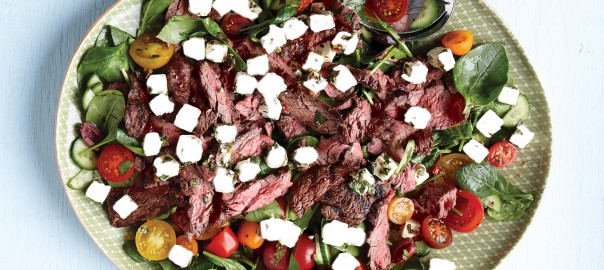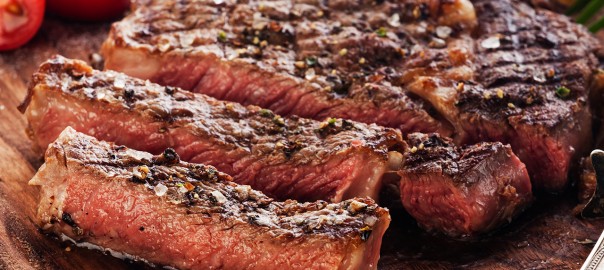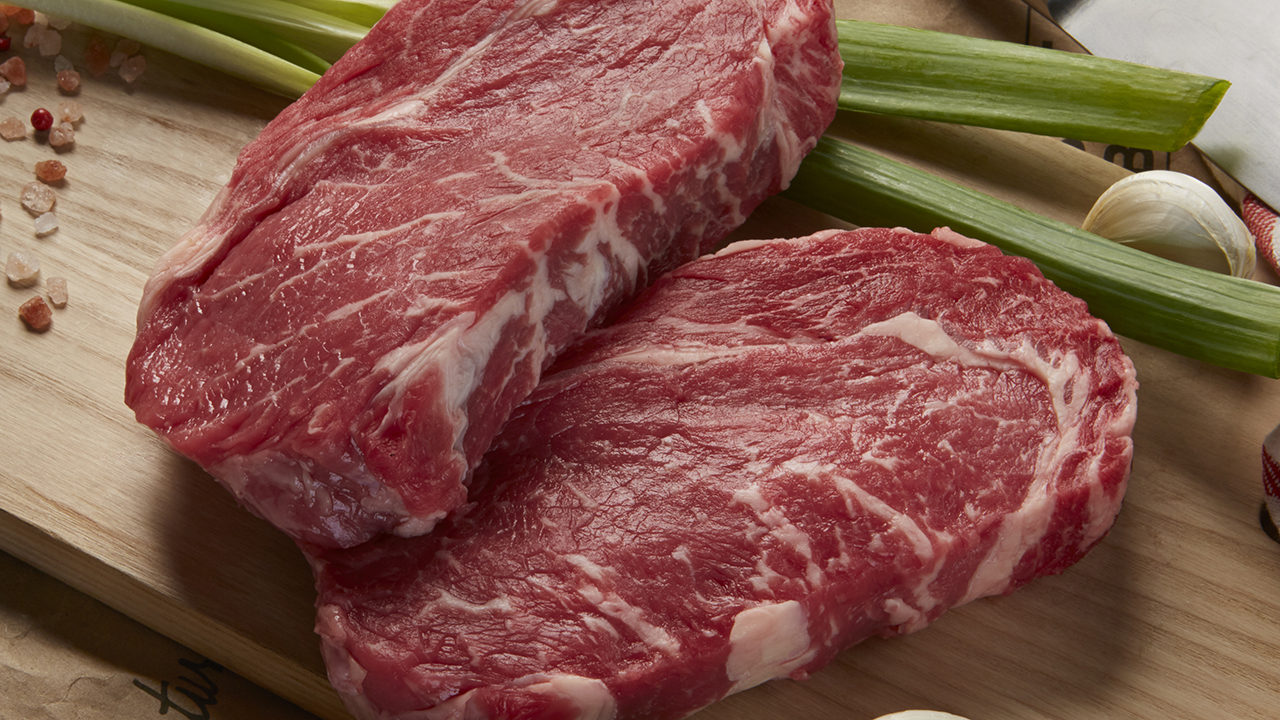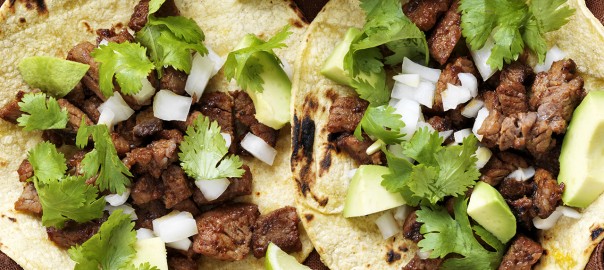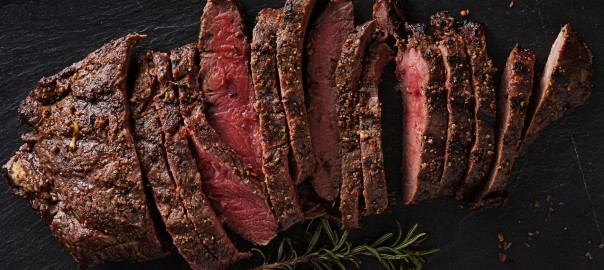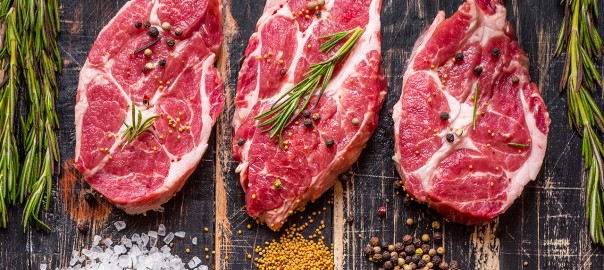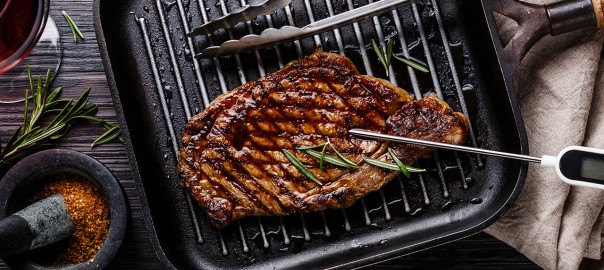When you think of meaty, hearty, satisfying meals, salads may not be the first thing that comes to mind. But salads, with their plentiful varieties, are a brilliant way to get in a balanced, nourishing meal.
Whether it’s a meat-packed salad complemented by fruits and veggies — like this tarragon and 3 apple chicken salad—or it’s a mound of grilled steak served atop a bed of lettuce and other veggies, salads pack in nutrients without compromising flavor.
You’re not limited to lettuce, either. Try cold noodle salads or veggie varietal salads. Whatever kind of meaty salads you’re craving, this list of salad recipes delivers substantial, vibrant, and healthy meals.
Tarragon and 3 Apple Chicken Salad
Need an easy, delicious, and nutritious salad that will fuel you till dinner? Try this tarragon and 3 apple chicken salad, rife with zingy flavors from tarragon, white wine (preferably one with stone fruit notes), garlic, Dijon mustard, and more.
The salad itself boasts a crisp variety of apples, including Granny Smith, Gala, and Honeycrisp. Celery and pistachios add even more crunch. At the center of it all is ultra-tender, ultra-juicy grilled chicken breast cubes.
Spring Pea Chicken Salad
This spring pea chicken salad is the epitome of spring, thanks to the abundance of seasonal produce and deliciously refreshing poached chicken breast. Enjoy fresh peas, sugar snap peas, pea shoots, dried apricots, and almonds for a delicious textural meld.
The chicken is poached in a white wine, thyme, and butter mixture, making for fork-tender, refreshing meat. The salad dressing is impressive in and of itself, with white balsamic vinegar, shallots, thyme, avocado oil, dried apricots, salt, and pepper. For even more flavor, make the dressing one day in advance and dress the chicken in the vinaigrette before serving.
Grilled Greek Marinated Chicken Breast with Peach and Endive Salad
Here’s a hearty salad that you can throw together in 30 minutes. While simple, this grilled Greek marinated chicken breast with peach and endive salad does not compromise on flavor. Marinated in a zingy Greek vinaigrette (we like the one created by Primal Kitchen), the chicken is grilled for a few minutes for the perfect char then finished off in the oven. An abundance of produce joins this grilled chicken salad, including peaches, avocado, endive, red onion, scallions, and corn. Throw in some feta cheese for even more zest, and you’re in for a nourishing, complete, and healthy meal.
Lemon Turmeric Marinated Flank Steak with Lentil and Beet Salad
This lemon turmeric marinated flank steak with lentil and beet salad couldn’t be easier to throw together. Perfectly cooked flank steak, which cooks up in minutes, and a salad of pre-cooked lentils, pre-cooked beets, and curry-seasoned and roasted cauliflower, are all dressed in lemon turmeric vinaigrette. This salad is a bevy of textures and flavors and makes for an ideal, speedy weeknight dinner or a make-ahead meal.
Seared Flat Iron Steak with Roasted Veggie Salad
If you’re craving all the trappings of a salad but prefer something warm, this seared flat iron steak with roasted veggie salad delivers. Flat iron steaks are seared and basted in butter then transferred to the oven to finish up for a few minutes. Then, turn up your oven and toss in a mélange of cauliflower, butternut squash, and Portobello mushrooms. Once those are thoroughly roasted, serve everything on a bed of greens with some crisp bacon and pomegranate arils. Toss in a salad dressing of orange juice, balsamic vinegar, whole grain mustard, shallots, orange zest, garlic, and olive oil. You’re good to go.
Thai Almond Soba Noodle Salad
Asian noodle salads make for a cool, creamy and refreshing meal any time of the day, and this Thai almond soba noodle salad is no exception. While it requires a bit of prep time, it cooks up incredibly fast.
Hearty flank steak gets the umami treatment with a marinade of fresh ginger, Tamari, mirin, garlic, fish sauce, and sambal chili paste. Seared quickly in a cast iron skillet then finished in the oven in minutes, it’s ultra-tender and flavorful. Cooked soba noodles are tossed with broccoli, red pepper, sugar snap peas, carrots, and toasted almond slices. An insanely flavor-packed Thai almond sauce finishes the dish off, complete with sesame oil, garlic, ginger, green curry paste, lime juice, tamari, honey, sambal chili paste, fish sauce, almond butter, coconut milk, salt, and cilantro.
Greek Salad with Primal Kitchen Greek Vinaigrette Chicken Skewers
This simple Greek salad with Primal Kitchen Greek Vinaigrette chicken skewers takes minutes to throw together. Simply marinate chicken beforehand in Greek vinaigrette, then grill it on skewers for 10 to 14 minutes. Toss together romaine lettuce, artichoke hearts, cherry tomatoes, English cucumber, Kalamata olives, and red onion. Throw in some more of the Greek salad dressing, and you’ve got a light but filling grilled chicken salad full of tangy and satisfying flavors.
Pork, Tomato, and Mango Salad
Sick of just having chicken or steak on your salad? Pork tenderloins, ever-admired for their versatility, make a great stand-in here. For this pork, tomato, and mango salad, grill pork tenderloin and corn on the cob for perfect charred flavor, then toss the pair on top of a salad of romaine lettuce, mango, tomato, cucumber, and red onion. Dress the whole thing in a simple balsamic vinaigrette, and you’re in for a tangy, sweet and savory meal.
Southwestern Steak Salad with Jalapeno Ranch Dressing
Need a steak salad with Southwestern flair? Try this Southwestern steak salad with jalapeno ranch salad dressing, chock full of big, bold flavors. With taco-seasoned, grilled top sirloin steak and a diverse veggie and bean selection, this romaine salad is hearty and satisfying. Enjoy the combination of Roma tomatoes, corn, avocado, red onion, black beans, and of course, romaine lettuce. Throw in a homemade spicy jalapeno ranch dressing, and you’re in for a treat.
